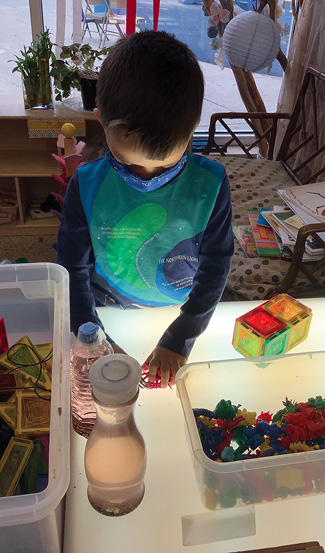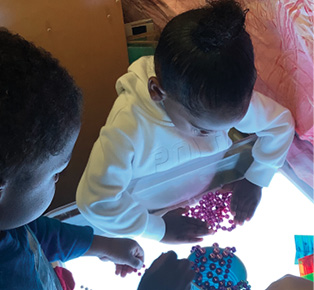The Early Years
Design Thinking With Preschoolers
Science and Children—January/February 2022 (Volume 59, Issue 3)
By Shelly Lynn Counsell
As preschoolers explore and investigate, they pose problems, ask questions, gather information (including observational data), and use the information to revise their ideas. While engineering design provides a useful context that helps children figure out how the world works, a focus on design is to intentionally develop an object, system, or process that addresses a specified need, solves a particular problem, or satisfies a targeted goal.
Design thinking generally refers to a “solution-based” technique used to solve problems. A design process puts design thinking into action, as preschoolers develop into deeper thinkers and doers (Wise 2016), learning to generate and develop their own ideas in meaningful, purposeful ways. Design taps into children’s creativity as they recognize, understand, identify/re-define problems, brainstorm, and then try out their ideas.

Children as young as two can ask “how” and “why” questions, recognize patterns, focus on a goal, monitor their progress, make corrections or adjustments, and evaluate their results as they encounter design challenges within their daily activities, developing into sophisticated problem-solvers in the preschool years (Bagiati and Evangelou 2011). Design challenges further encourage learners to explore, take risks, develop persistence, and learn to accept and embrace mistakes without fear of failure, leading to greater creative confidence with each new challenge and resulting innovation (Carrol et al. 2010).
Children’s imaginations are better stimulated when they work with actual materials, discussing their ideas, and investigating how materials can be changed. Children frequently make design choices during their imaginative play, such as using cardboard boxes to construct a fort or placing an object in a light path to intentionally cast a shadow. Light is a phenomenon that young children can easily explore and investigate, offering a wide range of design challenges within both natural and human-made worlds.
- Light table
- Transparent items (plastic bottles, bubble wrap, plastic bags)
- Transluscent items (plastic bottles with colored water, colored stacking blocks, nylon, gems, leaves)
- Opaque items (beads, buttons, poker chips, pom-poms, craft sticks)
- Adhesive materials (scotch tape, electric tape, masking tape, painter’s tape, utility tape)
- Construction materials (cardboard boxes, wood dowels, pvc pipes, paper towel tubes)
- Cultural items (suncatchers, stained glass, ornaments, kaleidoscopes, Japanese paper lanterns)
Design Thinking With Light Phenomena
Purpose
As preschoolers investigate how light interacts with different materials, they observe which materials (1) let all light pass through (transparent), (2) let some light pass through (transluscent), and (3) block the light from passing through (opaque).
In the forthcoming book Investigating Light and Shadow With Young Children, editor Beth Van Meeteren notes children’s engineering often begins with a broad question such as, “How can I use light with these materials?” It is under this overarching problem that children first imagine and then contemplate the many possibilities, leading to their own design challenges to produce an image or effect by combining different materials with light. As preschoolers produce their designs, they encounter unexpected problems or failures, challenging them to find creative solutions by revising or changing, eventually improving their design ideas.

In one preschool classroom, three-year-olds explored different materials at the light table, observing how transparent (water bottles) and transluscent objects (colored crystal blocks) respond differently to light in comparison to opaque items like beads. The teacher later observed children holding up items at the sliding door.
As children apply their scientific knowledge and reasoning about how various items respond to sunlight, they can actively use design thinking to:
- Figure out how to adhere items directly to the sliding door using a variety of adhesive materials to observe the physical properties (transparent, transluscent, and opaque) of both the adhesive materials and the objects displayed.
- Discuss how engineering design was used to create different types of adhesive technology with advantages for designed purposes (e.g., scotch tape used with gift wrapping).
- Figure out how to display different items without adhering to the glass (e.g., hanging items).
- Build structures or stands to display items.
- Explain their logic and reasoning for selecting specific types of tape to achieve their design product (e.g., why duct tape works better than scotch tape to construct structures or stands).
- Reflect on and share cultural photos and items used to transform light into stunning living color (e.g., stained glass in places of worship; suncatchers; crystal glass prisms; glass icicles; ornaments; kaleidoscope).
The teacher surprised the class by later covering the glass door with transluscent contact paper. She watched one child take color tissue squares from the art center and place them on the contact paper. As other children joined in, they became excited when they overlapped colors, creating other colors (e.g., overlapping blue and yellow to make green).
We can further challenge preschoolers to use other artificial light sources such as flashlights, desk lamps, cell phone lights, overhead projectors, night light, and tea lights with opaque items to cast shadows of different sizes, shapes, and positions. Bringing in related children’s literature (such as Moonbear’s Shadow by Frank Asch) encourages children to closely observe, describe, and compare their growing understanding of light and shadow to those of characters in books.
Shelly Lynn Counsell (slcnsell@memphis.edu) is an associate professor of early childhood education at the University of Memphis.
Engineering Interdisciplinary Teaching Strategies Technology Early Childhood


